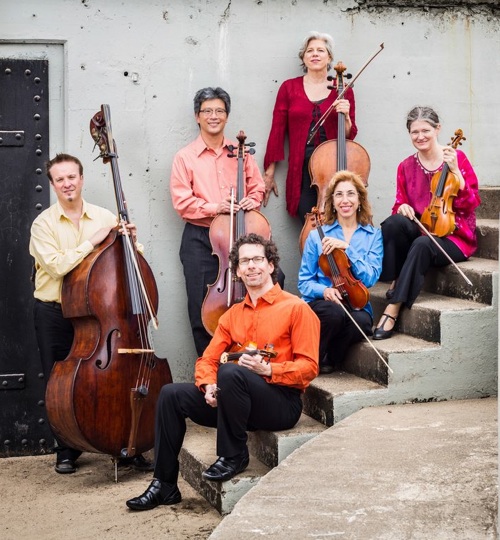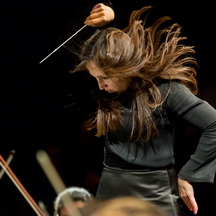String textures—from Hungarian shock to Brahmsian awe
At their December 9 concert, the Left Coast Chamber Ensemble emphasized the unlikely breadth of string writing with moods that ranged from nostalgic to sarcastic. Like the facility of emotion in black and white photography, which deals in texture rather than color, strings are freighted with feeling in the right hands, perhaps because they have the densest overlap of vibrations of any tonal instrument.
That was amply demonstrated on the intimate stage of the Dennis Gallagher Arts Pavilion, around the corner from the San Francisco Music Conservatory in a thickening downtown Arts District—which now includes the new SF Jazz Center and the Center for New Music.
Cellist Tanya Tomkins took the stage to explain that, besides the variety of string writing, a second thread through the works was the use of folk themes, from Edgar Meyer’s Appalachian airs to Brahms’ Hungarian themes.
They began with the first movement from Meyer’s Concert Duo for Violin and Double Bass, alternating rich accords and acrobatic runs. Meyer wrote this as a duet for himself and famed violinist Joshua Bell, and though it began in the dense center of the instrument, it later ascended into regions above even the cello for a more active dialogue with violin. Michel Taddei, the awesome first bass of the Berkeley Symphony, worked to overcome the inherent difficulties of this piece, hugely sonorous in the deep waters and playful in the folky parts. Violinist Anna Presler, Left Coast’s artistic director, was a worthy ally in a part that could easily be adversarial. Their most successful accord was in the slow harmonies, low in both instruments, and the least was the composer’s insistence on the nasal wail of the end of the high bass string, coupled with a repetitious violin design.
Presler redeemed herself in the next piece, György Ligeti’s first string quartet, written “for the bottom drawer” while he was still living in Hungary under oppressive Russian rule. He later escaped to Vienna, exploring new electronic tonalities before developing his “micropolyphonies,” and it was here that his Quartet No. 1 was first performed. It had the bleak beauty and sarcasm of Shostakovich, coupled with in-your-face modernism, and the Left Coast players gave it its due.
Slow chromatic ascents and lyrical violins built a feeling of suspense that resolved with a violent fall down the scales and a turn-about into violence. Presler was sublimely fierce, forsaking Greek muses for a Hindu Kali, against Leighton Fong’s cello, which was all earthy loam at the bottom, rather than the expected gravel. Phyllis Kamrin on violin and Pei-Ling Lin on viola joined for a sere landscape, strings parched dry and building to thin chords. Without pausing for movement breaks, they leaned into a section of sarcasm, all sharp strokes and sharper breaks. Here Ligeti treated thick gorgeous harmonies like criminals, with up-whips and a grinding of bows.
They re-invented themselves with a lumbering waltz, and again with slippery textures and glassy harmonies, and violist Lin added moments of warm depth. Prefiguring his move into—and later, out of—electronic textures, this quartet is a glorious fusion of Hungarian folk themes and wild experimentation.
After intermission we heard Kurt Rohde’s short and quizzical Hear No Evil for String Septet (2012). The violist/composer described it. “It is based on a sculpture by Arneson… but you can’t really compose about a sculpture. But, like that mischievous sculpture, it seems to be winking at you, and so the piece itself is ‘Being a Bad Boy.’ It also has themes from Copland’s Appalachian Spring… and you’ll get a free ticket if you can tell me where they appear!”
Like the Ligeti, it was fiercely independent, with a rhythmic section that was uncompromising. And then it ascended into sudden hollow harmonies, and one could discern Copland’s lovely openness. A sudden hoedown between violin and cello seemed to evoke the folk material, but without the score I doubt I could collect that free ticket.
 Then they buckled down for Johannes Brahms’ String Quintet No. 1, with Presler and Kamrin returning as violinists, Tanya Tomkins on cello, and Rohde and Lin as the two violas. Sumptuous accords, sudden summer squalls, and lingering notes took us to a dreamy place of quicksilver childhood moods and final farewells. This was Brahms in his ascendance, reverential and layered with time and nostalgia.
Then they buckled down for Johannes Brahms’ String Quintet No. 1, with Presler and Kamrin returning as violinists, Tanya Tomkins on cello, and Rohde and Lin as the two violas. Sumptuous accords, sudden summer squalls, and lingering notes took us to a dreamy place of quicksilver childhood moods and final farewells. This was Brahms in his ascendance, reverential and layered with time and nostalgia.
Rohde’s four-minute work was played again as an encore, even more enjoyable as his ‘bad boy’ revived us from reverie.
The Left Coast Chamber Ensemble’s next concert, “Some Serious Fun,” explores the dynamics of both playful fun and serious competition on Thursday, January 30 at 8 p.m. in Mill Valley’s 142 Throckmorton Theatre and repeats Monday, Feb. 3 at 8 p.m. at the SF Conservatory of Music. See www.leftcoastensemble.org for more information.
—Adam Broner
Photo on right, standing from left: Michel Taddei (double bass), Leighton Fong (cello), and Tanya Tomkins (cello); and seated from left: Kurt Rohde (viola), Phyllis Kamrin (violin), and Anna Presler (violin). Photo by Jordan Murphy.
